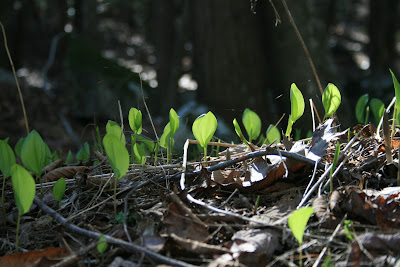While still in grade school I learned to identify mountain laurel and rattlesnake plantain and Christmas fern as we hiked up the mountain on summer days with my parents and siblings. Bay Road was quiet back then - we walked to a neighbor's driveway to catch the bus and hung around with our friends in the road. Today the road is a major thoroughfare, traffic is fast and loud at times and busy. But the view across the fields to Long Mountain remains.
We return often to visit my parents at Winterberry Farm, their home now for more than 55 years, and this weekend we celebrate Dad's 90th birthday. It is a lovely spring weekend, if a bit breezy. There is always lots to do outside at the old homestead. In between we find time for walks to the back forty and up into the hills. In recent years we've been hiking to Rattlesnake Knob just west of Long Mountain. The Knob provides a great view east to Long Mountain.
I've written before about the trail to Rattlesnake Knob as it passes through a beautiful oak-beech forest. The final ascent to the top of the knob is steep, but it is easy to pause along the way as the basalt-laden slope hosts many interesting plants. Today was no exception.
Hepatica had already flowered, although its leaves are beautiful too.
Two small clumps of cancer-root or bear corn (Conopholis americana) were emerging. This non-photosynthezing, parasitic plant was growing not far from the base of an oak tree, one of its favorite hosts. I've seen this plant only once before, from this same trail.
Large-flowered bellwort (Uvularia grandifolia) was flowering farther along the trail, near the top of the Knob. It's single pale yellow flower dangled from the plant's perfoliate leaves -- leaves that clasp the entire stem.My young nieces enjoy these outings more and more, gathering their own nature experiences based on what they see and feel and smell. Together we tore and sniffed the leaves of wintergreen and paused to see the hepatica leaves and bear corn stalks. They stopped and played with small stones and floated twigs and leaves down a small brook. It is always fun to spend time in the woods with them, watching them explore the very same places that I explored when I was their age.
These woods are full of interesting things to see, especially in spring when hardwoods are just leafing out and understory plants take advantage of the filtered light streaming through the canopy. We find something new every time we hike this trail.













































